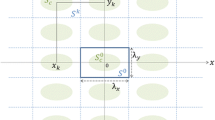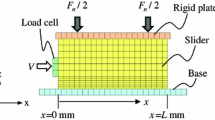Abstract
The noise generated by the friction of two rough surfaces under weak contact pressure is usually called roughness noise. The underlying vibration which produces the noise stems from numerous instantaneous shocks (in the microsecond range) between surface micro-asperities. The numerical simulation of this problem using classical mechanics requires a fine discretization in both space and time. This is why the finite element method takes much CPU time. In this study, we propose an alternative numerical approach which is based on a truncated modal decomposition of the vibration, a central difference integration scheme and two algorithms for contact: The penalty algorithm and the Lagrange multiplier algorithm. Not only does it reproduce the empirical laws of vibration level versus roughness and sliding speed found experimentally but it also provides the statistical properties of local events which are not accessible by experiment. The CPU time reduction is typically a factor of 10.
















Similar content being viewed by others
References
Akay A (2002) Acoustics of friction. J Acoust Soc Am 111(4):1525–1548
Amundsen D, Scheibert J, Thøgersen K, Trømborg J, Malthe-Sørenssen A (2012) 1d model of precursors to frictional stick-slip motion allowing for robust comparison with experiments. Tribol Lett 45:357–369
Anand A, Soom A (1984) Roughness-induced transient loading at a sliding contact during start-up. J Lubrication Technol 106(1):49–53
Andersson P, Kropp W (2008) Time domain contact model for tyre/road interaction including nonlinear contact stiffness due to small-scale roughness. J Sound Vib 318:296–312
Batailly A, Magnain B, Chevaugeon N (2013) A comparative study between two smoothing strategies for the simulation of contact with large sliding. Comput Mech 51(5):581–601
Ben Abdelounis H, Le Bot A, Perret-Liaudet J, Zahouani H (2010) An experimental study on roughness noise of dry rough flat surfaces. Wear 268(1–2):335–345
Ben Abdelounis H, Zahouani H, Le Bot A, Perret-Liaudet J, Tkaya MB (2010) Numerical simulation of friction noise. Wear 271(3–4):621–624
Bergstrom D (2012) Rough surface generation & analysis. http://www.mysimlabs.com. Accessed 26 Feb 2012
Boyko LS, Maruyamab S, Adachia K, Kato K (2007) The roughness effect on the frequency of frictional sound. Tribol Int 40(4):659–664
Bussetta P, Marceau D, Ponthot JP (2012) The adapted augmented lagrangian method: a new method for the resolution of the mechanical frictional contact problem. Comput Mech 49:259–275
Butlin T, Woodhouse J (2009) Friction-induced vibration: should low-order models be believed? J Sound Vib 328:92–108
Carpenter NJ, Taylor RL, Katona MG (1991) Lagrange constraints for transient finite element surface contact. Int J Numer Methods Eng 32(1):103–128
Chen J, Soom A (1986) Simulation of random surface roughness-induced contact vibrations at hertzian contacts during steady sliding. J Tribol 108(1):123–127
Delogu F, Cocco G (2006) Numerical simulations of atomic-scale disordering processes at impact between two rough crystalline surfaces. Phys Rev B 74(035):406
Dubois G, Cesbron J, Yin H, Anfosso-Lde F (2012) Numerical evaluation of tyre/road contact pressures using a multi-asperity approach. Int J Mech Sci 54(1):84–94
Garcia N, Stoll E (1984) Monte carlo calculation for electromagnetic-wave scattering from random rough surfaces. Phys Rev Lett 52(20):1798–1801
Graff KF (1975) Wave motion in elastic solids. Ohio State University Press, Columbus
Greenwood JA, Williamson JBP (1966) Contact of nominally flat surfaces. R Soc Lond Proc Ser A 295(1442):300–319
Haskell P (1961) Insect sounds. Witherby, London
Hess DP, Soom A, Akay A, Bengisu MT (1992) Normal and angular motions at rough planar contacts during sliding with friction. J Tribol 114(3):567–578
Johnson KL (1987) Contact mechanics. Cambridge University Press, Cambridge
Kapania R, Byun C (1993) Reduction methods based on eigenvectors and ritz vectors for nonlinear transient analysis. Comput Mech 11:65–82
Laursen T (2003) Computational contact and impact mechanics: fundamentals of modeling interfacial phenomena in nonlinear finite element analysis. Engineering online library. Springer, Berlin
Le Bot A, Bou Chakra E (2010) Measurement of friction noise versus contact area of rough surfaces weakly loaded. Tribol Lett 37:273–281
Le Bot A, Bou-Chakra E, Michon G (2011) Dissipation of vibration in rough contact. Tribol Lett 41(1):47–53
Lemaitre J (2001) Handbook of materials behavior models: multiphysics behavior. vol. 3. Academic Press, New York
Meziane A, Baillet L (2010) Non linear analysis of vibrations generated by a contact with friction. Eur J Comput Mech 19:305–316
Meziane A, D’Errico S, Baillet L, Laulagnet B (2007) Instabilities generated by friction in a pad disc system during the braking process. Tribol Int 40(7):1127–1136
Mohammadi S (2003) Discontinuum mechanics: using finite and discrete elements. WIT Press, Southampton
Norton P, Karczub D (2003) Fundamentals of noise and vibration analysis for engineers. Cambridge University Press, Cambridge
Olsson M (1991) On the fundamental moving load problem. J Sound Vib 145(2):299–307
Othman M, Elkholy A, Seireg A (1990) Experimental investigation of fritional noise and surface-roughness characteristics. Exp Mech 47:328–331
Puso MA, Laursen TA (2004) A mortar segment-to-segment frictional contact method for large deformations. Comput Methods Appl Mech Eng 193(4547):4891–4913
Rigaud E, Perret-Liaudet J (2003) Experiments and numerical results on non-linear vibrations of an impacting hertzian contact. Part 1: harmonic excitation. J Sound Vib 265(2):289–307
Trømborg J, Scheibert J, Amundsen DS, Thøgersen K, Malthe-Sørenssen A (2011) Transition from static to kinetic friction: insights from a 2D model. Phys Rev Lett 107(074):301
Yang B (2005) Stress, strain, and structural dynamics: an interactive handbook of formulas, solutions, and MATLAB toolboxes. No. vol. 1 in mechanical engineering. Elsevier Science, Burlington
Yokoi M, Nakai M (1979) A fundamental study of frictional noise. (1st report, the generating mechanism of rubbing noise and squeal noise). Bull JSME 22(173):1665–1671
Yokoi M, Nakai M (1980) Fundamental study on frictional noise: 2. The generating mechanism of squeal noise of higher modes. Bull JSME 23(186):2118–2124
Yokoi M, Nakai M (1981) Fundamental study on frictional noise: 3. The influence of periodic surface roughness on frictional noise. Bull JSME 24(194):1470–1476
Yokoi M, Nakai M (1981) Fundamental study on frictional noise: 4. The influence of angle of inclination of the rod on frictional noise. Bull JSME 24(194):1477–1483
Yokoi M, Nakai M (1982) Fundamental study on frictional noise: 5. The influence of random surface roughness on frictional noise. Bull JSME 25(203):827–833
Zavarise G, De Lorenzis L (2009) A modified node-to-segment algorithm passing the contact patch test. Int J Numer Methods Eng 79(4):379–416
Acknowledgments
This work was performed within the framework of the Labex CeLyA of Université de Lyon, operated by the French National Research Agency (ANR-10-LABX-0060/ANR-11-IDEX-0007).
Author information
Authors and Affiliations
Corresponding author
Rights and permissions
About this article
Cite this article
Dang, V.H., Perret-Liaudet, J., Scheibert, J. et al. Direct numerical simulation of the dynamics of sliding rough surfaces. Comput Mech 52, 1169–1183 (2013). https://doi.org/10.1007/s00466-013-0870-7
Received:
Accepted:
Published:
Issue Date:
DOI: https://doi.org/10.1007/s00466-013-0870-7




